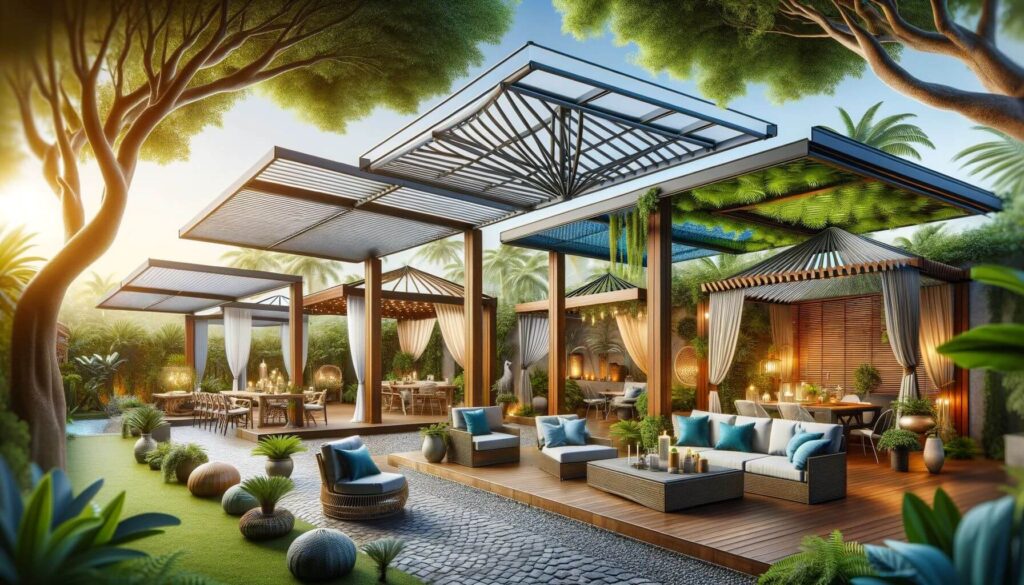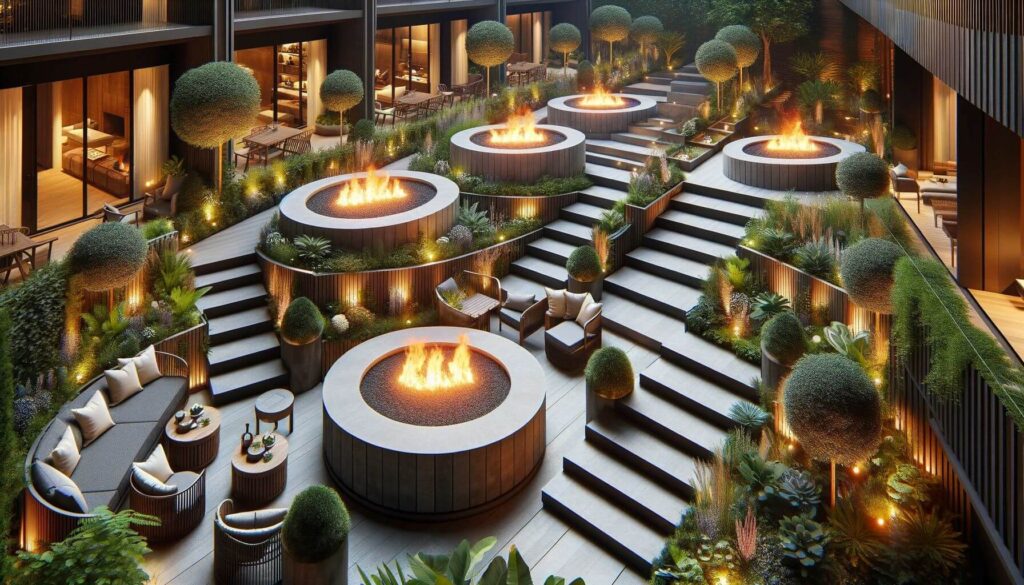
When most people think of outdoor kitchens, they imagine sunny summer days and warm evenings. However, with the right design and features, an outdoor kitchen can be a year-round entertainment space, even in the colder months. Let’s explore how to create an outdoor kitchen that’s perfect for winter use.
The benefits of a winter-ready outdoor kitchen
First, let’s consider why you might want an outdoor kitchen that’s usable in winter. Cold-weather cooking can be a unique and enjoyable experience. The crisp air can enhance flavors, and there’s something cozy about gathering around a warm grill on a chilly day. Plus, it extends the usability of your outdoor space, giving you more value for your investment.
Outdoor kitchen cabinets are a crucial component of a winter-ready setup. They provide storage for cooking utensils and ingredients, protecting them from the elements. Choose cabinets made from weather-resistant materials like stainless steel or marine-grade polymer to ensure they can withstand winter conditions.
Choosing the right location
The location of your outdoor kitchen is crucial for winter use. Ideally, it should be close to your home for easy access. Consider placing it near a door that leads to your indoor kitchen. This proximity will make it easier to transport food and supplies back and forth.
Additionally, think about natural wind barriers. Positioning your kitchen near a wall or fence can help block cold winds. If possible, orient your cooking area to take advantage of winter sunlight. This can provide some natural warmth during daytime cooking sessions.
Covering your outdoor kitchen

A covered outdoor kitchen is essential for winter use. A roof or pergola can protect your cooking area from snow and rain. Pergola roof ideas can range from solid structures to retractable awnings, giving you flexibility in your design.
For added protection, consider enclosing part or all of your outdoor kitchen. Retractable screens or glass panels can create a windbreak while still allowing you to enjoy the outdoor atmosphere. These can be opened in warmer weather for a more open-air feel.
Heating solutions
To make your outdoor kitchen comfortable in winter, you’ll need to incorporate heating solutions. There are several options to consider:
- Built-in heaters: Ceiling-mounted or wall-mounted heaters can provide targeted warmth to your cooking and dining areas.
- Fire pit: A fire pit can serve as both a heat source and a focal point for your outdoor kitchen.
- Outdoor fireplace: For a more substantial heating option, consider incorporating an outdoor fireplace into your kitchen design.
- Heated flooring: If you’re willing to invest more, heated flooring can make your outdoor kitchen comfortable underfoot even in the coldest weather.
Remember to choose heating options that are safe for outdoor use and comply with local building codes.
Winter-friendly cooking appliances

When selecting appliances for your winter outdoor kitchen, opt for those that can withstand cold temperatures. Stainless steel is a good choice as it’s durable and resistant to rust.
A high-quality grill is the centerpiece of any outdoor kitchen. Look for one with a high BTU output, which will help it maintain cooking temperatures in cold weather. Some grills come with insulated jackets, which can be helpful in winter.
Consider adding a pizza oven to your outdoor kitchen. These can reach high temperatures quickly, making them ideal for winter cooking. Plus, who doesn’t love a hot, freshly baked pizza on a cold day?
Lighting for winter evenings
Proper lighting is crucial for a winter outdoor kitchen, as daylight hours are shorter. Lighting tips for outdoor spaces can help you create a warm and inviting atmosphere. Consider a mix of task lighting for cooking areas and ambient lighting for dining spaces.
LED lights are energy-efficient and perform well in cold temperatures. String lights can add a festive touch, while under-cabinet lighting can provide necessary illumination for food prep areas.
Winterizing your water supply
If you live in an area where temperatures drop below freezing, you’ll need to winterize your outdoor kitchen’s water supply. This typically involves shutting off the water and draining the pipes to prevent freezing and bursting.
For convenience, consider installing a hot water dispenser. This can provide instant hot water for drinks or cooking without the need for running water lines that could freeze.
Comfortable seating options
To encourage winter use of your outdoor kitchen, provide comfortable seating options. Choose furniture made from materials that can withstand cold and moisture, such as teak or metal with weather-resistant cushions.
Outdoor furniture for your pergola can include pieces that work well for winter use. Look for seating with high backs to block wind, and consider adding throw blankets for extra coziness.
Storage solutions
Adequate storage is crucial for a winter outdoor kitchen. In addition to cabinets, consider adding a small shed or storage box for items you don’t need to access frequently. This can include summer-specific items or extra propane tanks.
Make sure your storage solutions are weather-tight to protect your belongings from moisture and pests. Using clear plastic bins can make it easy to see what’s stored where, even in low light conditions.
Flooring considerations
The right flooring can make a big difference in the comfort and safety of your winter outdoor kitchen. Waterproof outdoor flooring is essential to prevent slips on icy or wet surfaces.
Consider materials like textured concrete, which provides good traction. For a warmer feel underfoot, you might opt for interlocking deck tiles made from weather-resistant wood or composite materials.
Incorporating a bar area

A bar area can be a great addition to a winter outdoor kitchen. It provides a space for guests to gather while you’re cooking, and can be equipped with amenities like a small refrigerator or wine cooler.
Consider adding heat lamps above the bar area to keep guests comfortable. A pergola or roof overhang can provide additional protection from the elements.
Planning for snow removal
In areas that receive significant snowfall, plan for how you’ll remove snow from your outdoor kitchen area. Ensure there’s a clear path from your house to the kitchen, and consider the logistics of snow removal when designing your layout.
You might want to invest in a good quality snow shovel or snow blower to keep your outdoor kitchen accessible throughout the winter months.
Weatherproofing your electrical system
If your outdoor kitchen includes electrical appliances or lighting, make sure all wiring and outlets are properly weatherproofed. Use GFCI outlets and weather-resistant covers to protect against moisture.
Consider installing a dedicated circuit for your outdoor kitchen to prevent overloading your home’s electrical system. Always consult with a licensed electrician when planning and installing outdoor electrical features.
Adding windbreaks
Strategically placed windbreaks can significantly improve the comfort of your winter outdoor kitchen. These can be permanent features like masonry walls or adjustable elements like retractable screens.
Concrete edging ideas can be adapted to create low walls that serve as windbreaks while also defining your outdoor kitchen space.
Incorporating warm colors and textures
The visual design of your outdoor kitchen can contribute to a feeling of warmth. Incorporate warm colors and textures in your decor choices. This might include rich wood tones, warm metallic accents, or cozy textiles in your seating areas.
Consider adding outdoor-safe artwork or wall hangings to bare walls to create a more inviting atmosphere. Just be sure any decor items can withstand winter weather conditions.
Planning for winter grilling
Grilling in winter requires some special considerations. Keep a cleared path to your grill and store fuel nearby. Remember that grills will take longer to heat up in cold weather, so plan accordingly.
Always keep a fire extinguisher easily accessible, and never grill in an enclosed space due to the risk of carbon monoxide buildup.
Incorporating winter-friendly plants

While many plants go dormant in winter, you can still incorporate greenery into your outdoor kitchen design. Consider evergreen plants in pots or built-in planters. Hardy herbs like rosemary can survive in many climates and provide fresh flavors for winter cooking.
Plant companions for patio furniture can include winter-blooming flowers or plants with interesting bark or branch structures for visual interest.
Maintenance considerations
Regular maintenance is crucial for keeping your outdoor kitchen in good condition through the winter. This might include covering grills and other appliances when not in use, regularly clearing snow and ice, and checking for any damage from freezing temperatures.
Consider applying a sealant to any masonry surfaces to protect against moisture damage from freeze-thaw cycles.
Creating ambiance with fire features
In addition to providing warmth, fire features can create a cozy ambiance in your winter outdoor kitchen. Fire pit lighting can provide both heat and illumination.
Consider incorporating a fireplace or fire table into your design. These can serve as focal points and gathering spots in your outdoor kitchen area.

Planning for indoor-outdoor flow
For the ultimate winter outdoor kitchen, consider how it connects to your indoor living spaces. Large sliding or folding doors can create a seamless transition between indoor and outdoor areas.
You might even consider a design where part of the kitchen is indoors and part outdoors, allowing you to move between the two spaces as weather permits.
In conclusion, with thoughtful design and proper features, an outdoor kitchen can be a delightful space even in the winter months. From heating solutions and weather-resistant materials to cozy seating and ambient lighting, there are many ways to create an inviting outdoor cooking and entertaining area that you can enjoy year-round. Remember to prioritize safety, especially when dealing with heating elements and winter weather conditions. With these considerations in mind, you can create an outdoor kitchen that brings warmth and joy to even the coldest winter days.



